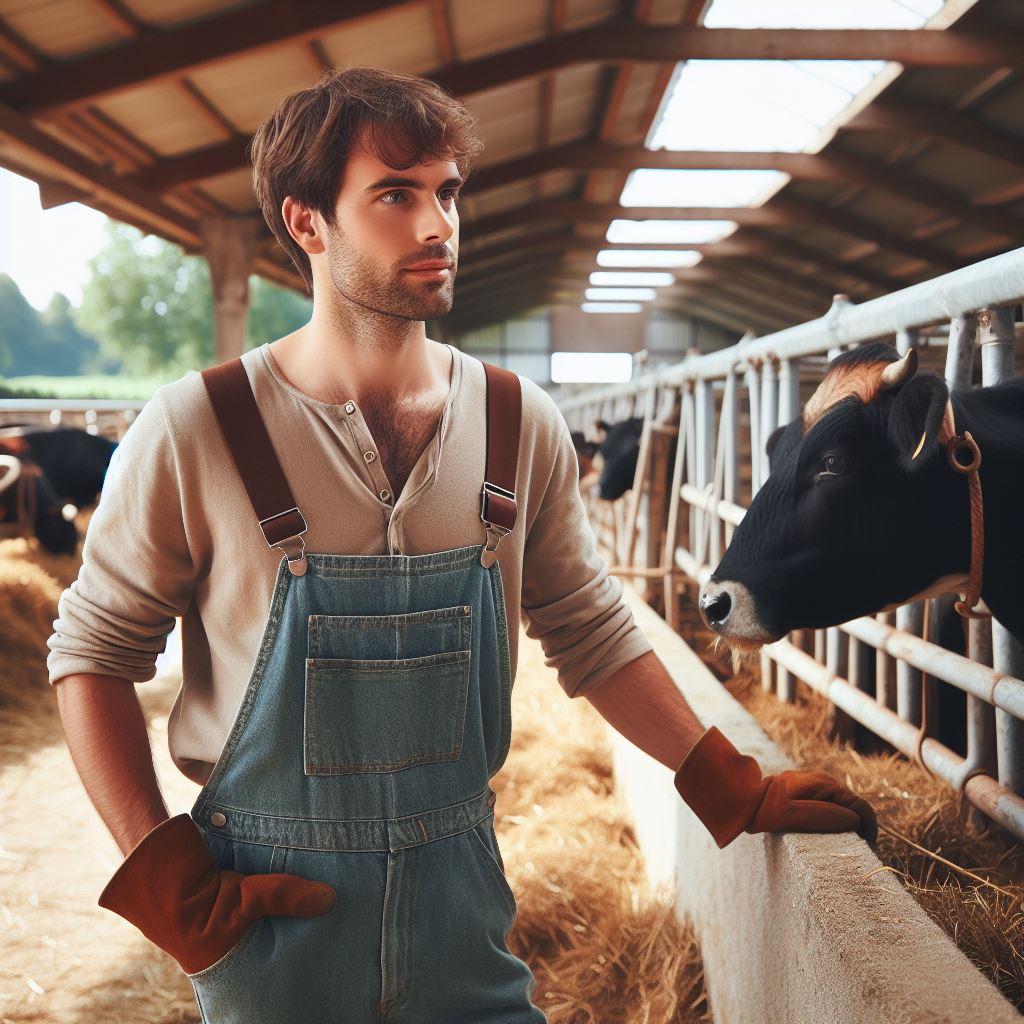Introduction
Dairy farming stands as a cornerstone of New Zealand’s agricultural landscape, not only playing a pivotal role in sustaining rural communities but also exerting a substantial influence on the nation’s economy.
With its lush pastures and temperate climate, New Zealand is renowned for its dairy industry, which has become synonymous with the country’s identity.
The significance of dairy farming extends far beyond the confines of agriculture; it shapes cultural practices, environmental policies, and international trade relations.
A. Importance of dairy farming in New Zealand
Dairy farming holds a prominent position within New Zealand’s economy, contributing significantly to the nation’s gross domestic product (GDP) and providing a livelihood for thousands of farmers across the country.
The industry not only generates revenue through milk production but also fuels ancillary sectors such as manufacturing, transportation, and tourism.
Moreover, dairy exports play a crucial role in balancing the nation’s trade deficit, with New Zealand ranking among the world’s leading dairy exporters.
B. Overview of the main objectives of the blog post
In this blog post, we aim to delve deep into the methods and markets of dairy farming in New Zealand, shedding light on the innovative practices employed by farmers to enhance productivity while ensuring sustainability.
From pasture management techniques to advancements in animal husbandry, we will explore the myriad of strategies adopted by New Zealand dairy farmers to optimize efficiency and mitigate environmental impact.
Additionally, we will examine the dynamic landscape of dairy markets, both domestic and international, uncovering trends, challenges, and opportunities that shape the industry’s trajectory.
By providing a comprehensive overview, we seek to offer valuable insights into the multifaceted realm of dairy farming in New Zealand, catering to farmers, industry stakeholders, and enthusiasts alike.
Overview of Dairy Farming in NZ
A. Significance and scale of the industry
Dairy farming plays a vital role in New Zealand’s economy, contributing significantly to its GDP.
With over 10,880 dairy farms operating across the country, the industry holds immense significance.
It is the largest sector within the agricultural industry, employing thousands of people and generating substantial income.
B. New Zealand’s favorable climate and natural resources for dairy farming
New Zealand’s climate is well-suited for dairy farming, with moderate temperatures and abundant rainfall.
The country’s fertile lands and ample water resources provide perfect conditions for high-quality pasture growth.
Personalized Career Consulting
Unlock your potential with expert career advice tailored to your goals. Get personalized guidance and actionable steps toward your dream career in New Zealand.
Get StartedThese natural resources allow for the endless grazing of cows, resulting in superior milk production.
New Zealand’s isolation from major disease risks also ensures the health and quality of its dairy products.
The clean and pristine environment further adds value to the reputation of New Zealand dairy farming.
Overall, the combination of favorable climate and natural resources positions New Zealand as a leading dairy producer.
The industry’s contribution to the country’s economy and global reputation should not be underestimated.
It is a crucial part of New Zealand’s identity and a significant player in the international dairy market.
The next section will delve into the specific methods and practices employed in New Zealand’s dairy farming industry.
Read: Livestock Farming: New Zealand’s Approach
Dairy Farming Methods in NZ
A. The pasture-based farming method
The extensive use of grass and grazing in dairy farming helps showcase the country’s commitment to sustainable and natural agricultural practices.
By primarily relying on pasture-based farming, New Zealand ensures the production of high-quality dairy products while minimally impacting the environment.
The grass-based system allows cows to freely roam and feed on lush pastures, resulting in healthier animals and milk with better nutritional qualities.
This method also helps farmers reduce costs since grass is a readily available and affordable feed source.
However, pasture-based farming does come with its own set of challenges.
One major concern is the dependence on weather conditions for grass growth and availability.
Transform Your Career with a Professional CV and Cover Letter
Stand out to employers with an ATS-optimized resume and tailored cover letter designed to match your dream role. Let us craft your job application materials for success!
Get StartedDry spells or excessive rainfall can affect the quantity and quality of the grazing resources, potentially impacting overall milk production.
Additionally, pasture-based farming requires effective land management practices to ensure sustainable land use.
Overgrazing and inadequate pasture rotation can lead to soil degradation and decreased productivity over time.
Farmers need to carefully monitor and maintain their grazing areas to avoid these problems.
B. Confinement farming method
On the other hand, confinement farming systems have gained some popularity in recent years due to their potential for higher efficiency and year-round milk production.
Indoor housing and controlled feedlots allow for centralized animal management and access to a consistent diet.
Confinement farming also offers advantages in terms of disease control. Cattle are closely monitored, preventing the spread of contagious ailments and facilitating treatment if necessary.
Moreover, a controlled feed regime enables precise nutrient management, enhancing milk quality.
However, confinement farming has its drawbacks. The costs associated with building and maintaining indoor facilities, as well as purchasing supplementary feed, can be significant.
Furthermore, concerns regarding animal welfare and potential environmental impacts persist, raising ethical and sustainability considerations.
C. Predominant use of pasture-based farming in New Zealand
Despite the advantages of confinement farming, pasture-based farming remains the more prevalent method in New Zealand.
The country’s favorable climate and abundant grazing land make it an ideal environment for this traditional practice.
In essence, both pasture-based farming and confinement farming methods are employed in New Zealand’s dairy industry.
Pasture-based farming, with its emphasis on grass and extensive grazing, remains the primary approach.
Boost Your Career with a Standout LinkedIn Profile
Attract recruiters and expand your network with a fully optimized LinkedIn profile tailored to highlight your strengths and professional goals. Let your profile open doors to new opportunities!
Get OptimizedHowever, confinement farming offers certain advantages and has gained traction in specific scenarios.
The balance between the two methods ensures a diversified and adaptable dairy sector in New Zealand.
Read: Technology’s Role in Modern NZ Agriculture
Dairy Farming Practices in NZ
A. Overview of the management practices implemented on dairy farms
Implementing effective management practices is crucial for successful dairy farming in New Zealand.
Dairy farms have rigorous systems in place for monitoring and managing herd health and reproduction.
Regular veterinary checks, vaccinations, and preventive treatments help maintain the health of the dairy cattle.
Efficient grazing management techniques ensure optimal use of pasture and minimize environmental impacts.
Dairy farmers also employ advanced technologies for monitoring milk production, fertility, and overall herd performance.
B. Breeding and genetics strategies for dairy cattle
Genetic improvement plays a significant role in the dairy farming industry in New Zealand.
Breeding strategies focus on selecting cows with desirable traits such as high milk production and disease resistance.
Artificial insemination techniques are commonly used to ensure optimal genetics and improve the quality of the dairy herd.
Genomic testing allows farmers to identify superior breeding stock and make informed decisions for future generations.
Ongoing research and collaboration among farmers, scientists, and breeding companies drive genetic progress in the industry.
C. Feeding and nutrition practices
Dairy cattle in New Zealand are primarily grass-fed, taking advantage of the country’s abundant pasture resources.
Supplementary feeding with crops, silage, and concentrates is done strategically to meet nutritional requirements.
Nutritionists and farm consultants provide guidance on formulating balanced diets for different stages of lactation and growth.
Efforts are made to optimize feed utilization, reduce wastage, and minimize environmental impacts.
Regular analysis of feed quality and monitoring cow body condition ensures optimal nutrition and herd performance.
D. Milk production and milk quality control measures
New Zealand is renowned for its high milk production per cow, owing to efficient farming practices.
Dairy farmers closely monitor milk production, conducting regular milk yield testing and using modern milking systems.
Stringent milk quality control measures are in place to ensure low bacterial counts and the absence of antibiotic residues.
Regular milk testing and on-farm hygiene protocols contribute to the production of safe and premium-quality milk.
New Zealand’s reputation for high milk quality allows its dairy products to compete successfully in global markets.
E. Animal welfare standards and initiatives
Dairy farming in New Zealand places strong emphasis on animal welfare and humane treatment of dairy cattle.
Adherence to the Animal Welfare Act and the National Animal Welfare Code of Practice is required.
Farmers provide comfortable housing, proper bedding, and access to clean water and nutritious feed for the cows.
Regular health checks, vaccinations, and prompt treatment of illnesses or injuries are part of the animal welfare practices.
Continual improvements in animal welfare standards and initiatives ensure the well-being of dairy cattle in New Zealand.
Read: Organic Farming Trends Among NZ Farmers

Dairy Markets in NZ
A. Introduction to the domestic and international markets for dairy products
Dairy farming in New Zealand is not only an important contributor to the country’s economy but also a key player in the global dairy market.
The dairy industry in NZ is heavily dependent on both domestic and international markets for its products.
In the domestic market, dairy products play a crucial role in fulfilling the nutritional needs of the population.
NZ is known for its high-quality dairy products, which are widely consumed by its residents.
The demand for dairy products in the domestic market remains stable and consistently high.
On the international front, NZ is one of the largest exporters of dairy products.
The country’s dairy industry is highly reliant on global markets to sell its surplus dairy products, particularly milk powder, butter, and cheese.
NZ has gained a strong reputation for producing high-quality dairy products, which are sought after by consumers worldwide.
B. Overview of the major export destinations for New Zealand dairy
New Zealand exports its dairy products to numerous countries across the globe.
The major export destinations for NZ dairy products include:
- China: China is the largest market for NZ dairy exports. Its growing middle class and increasing demand for dairy products make it a crucial market for NZ farmers.
- United States: The US is another significant market for NZ dairy imports. The US market offers opportunities for various dairy products, including cheese and butter.
- Australia: Close proximity and strong trade ties make Australia an important market for NZ dairy products. Both countries engage in significant dairy trade.
- United Kingdom: The UK also imports a significant amount of NZ dairy products. This market offers a potential opportunity for growth, particularly in the post-Brexit era.
- Southeast Asia: Countries like Malaysia, Indonesia, and Thailand are emerging markets for NZ dairy exports.
Growing urbanization and increasing disposable income contribute to the rising demand for dairy products in this region.
C. Main dairy products produced and exported in NZ
New Zealand primarily produces and exports several key dairy products, including:
- Milk Powder: NZ is renowned for its high-quality milk powder, both in skimmed and full cream varieties.
Milk powder is a versatile product and is widely used in various food and beverage applications globally. - Butter: NZ produces and exports a significant amount of butter. NZ butter is known for its creamy texture and rich taste, making it highly sought after in international markets.
- Cheese: Cheese production is another significant segment of the NZ dairy industry
NZ produces various types of cheese, including cheddar, mozzarella, and feta, catering to diverse consumer preferences. - Yogurt: While not as prominent as milk powder, butter, and cheese, NZ also produces and exports yogurt. NZ yogurt is known for its high-quality ingredients and unique flavors.
D. Key challenges and opportunities in the dairy market
The dairy market in NZ faces various challenges and opportunities.
Key challenges include:
- Market Volatility: Global dairy markets are subject to price fluctuations, which can impact NZ dairy farmers’ profitability.
- Environmental Sustainability: Dairy farming has environmental implications, and NZ is striving to address sustainability concerns, such as water quality and greenhouse gas emissions.
- Trade Barriers: Geopolitical factors and trade agreements can impact NZ’s dairy exports, leading to market access challenges.
E. Opportunities in the NZ dairy market
- Emerging Markets: Growing populations and rising incomes in emerging markets provide opportunities for increased dairy exports.
- Product Innovation: There is room for product diversification and innovation to cater to evolving consumer preferences and tap into niche markets.
- Organic and Specialty Products: Demand for organic and specialty dairy products is increasing globally. NZ has the potential to capitalize on this growing market segment.
In fact, the dairy markets in NZ, both domestic and international, play a significant role in the success of the country’s dairy industry.
Despite challenges, NZ continues to excel in producing high-quality dairy products and exploring new markets for export.
The future of the dairy market in NZ looks promising, with potential opportunities for growth and innovation.
Read: Kiwi Farmers’ Challenges: Climate and Beyond
Sustainable Dairy Farming in NZ
A. Growing Focus on Sustainability in the Industry
Sustainable dairy farming is a growing focus in the New Zealand industry, driven by the recognition of the need to protect the environment and ensure the long-term viability of the sector.
Farmers are becoming increasingly aware of their role in preserving natural resources for future generations.
B. Overview of Sustainable Farming Practices and Initiatives in NZ
New Zealand dairy farmers have adopted various sustainable farming practices to reduce their environmental impact.
These practices include efficient water use, greenhouse gas emission reduction, and waste minimization.
They are making investments in technologies that improve resource management and reduce environmental implications.
Initiatives such as riparian planting and wetland restoration enhance biodiversity and improve water quality.
Moreover, pasture-based farming systems are being promoted, prioritizing animal welfare and reducing reliance on supplementary feeds.
C. Environmental Impact and Mitigation Efforts
While dairy farming, like any agricultural sector, has an environmental impact, efforts are being made to mitigate these impacts through sustainable practices.
Nutrient runoff, water pollution, and greenhouse gas emissions are the main concerns.
However, dairy farmers actively work on mitigating them through the adoption of sustainable practices.
Effluent and nutrient management systems help reduce water pollution and improve soil health.
Farmers are utilizing technologies to measure and manage nutrient application, ensuring optimal use and minimizing runoff.
Methods to reduce greenhouse gas emissions include the use of methane inhibitors, precision feeding, and improving cow genetics.
D. Certifications and Labels Promoting Sustainable Dairy Products
In response to the increasing demand for sustainable products, certifications and labels have been developed.
The “New Zealand Dairy Sustainability Framework” sets clear goals and commitments for the industry.
Both farmers and processors adhere to strict standards to obtain certifications such as “Dairy Tomorrow” and “New Zealand Grass-fed.”
These certifications reassure consumers that the dairy products they purchase are produced sustainably.
Additionally, labels such as “FernMark” and “Caring Dairy” promote sustainability and ethical practices in dairy farming.
Through sustainable farming practices, environmental impact mitigation efforts, and certifications promoting sustainability, the dairy farming industry in New Zealand continues to make strides towards a more sustainable future.
As consumers become more conscious of their choices, the demand for sustainable dairy products is likely to increase, encouraging farmers to further prioritize sustainable practices and promote environmental stewardship.
Conclusion
A. Recap
- Dairy farming in NZ employs advanced techniques like rotational grazing.
- The country’s dairy industry is known for its high-quality products.
- Market diversification includes exports to Asia, the Middle East, and the USA.
- Farmers use sustainable practices to minimize environmental impact.
B. Final Thoughts
- Dairy farming is crucial to NZ’s economy, contributing significantly to GDP.
- The industry faces challenges like environmental sustainability and market fluctuations.
- NZ’s dairy sector must continue innovating to maintain its global competitiveness.
- Government support and technological advancements are key to ensuring the industry’s future growth and sustainability.
In the end, dairy farming in NZ is not just about producing milk—it’s a complex system that intertwines economic, environmental, and social factors.
The industry’s future hinges on its ability to adapt to changing conditions, embrace sustainability, and maintain its high standards of quality.




